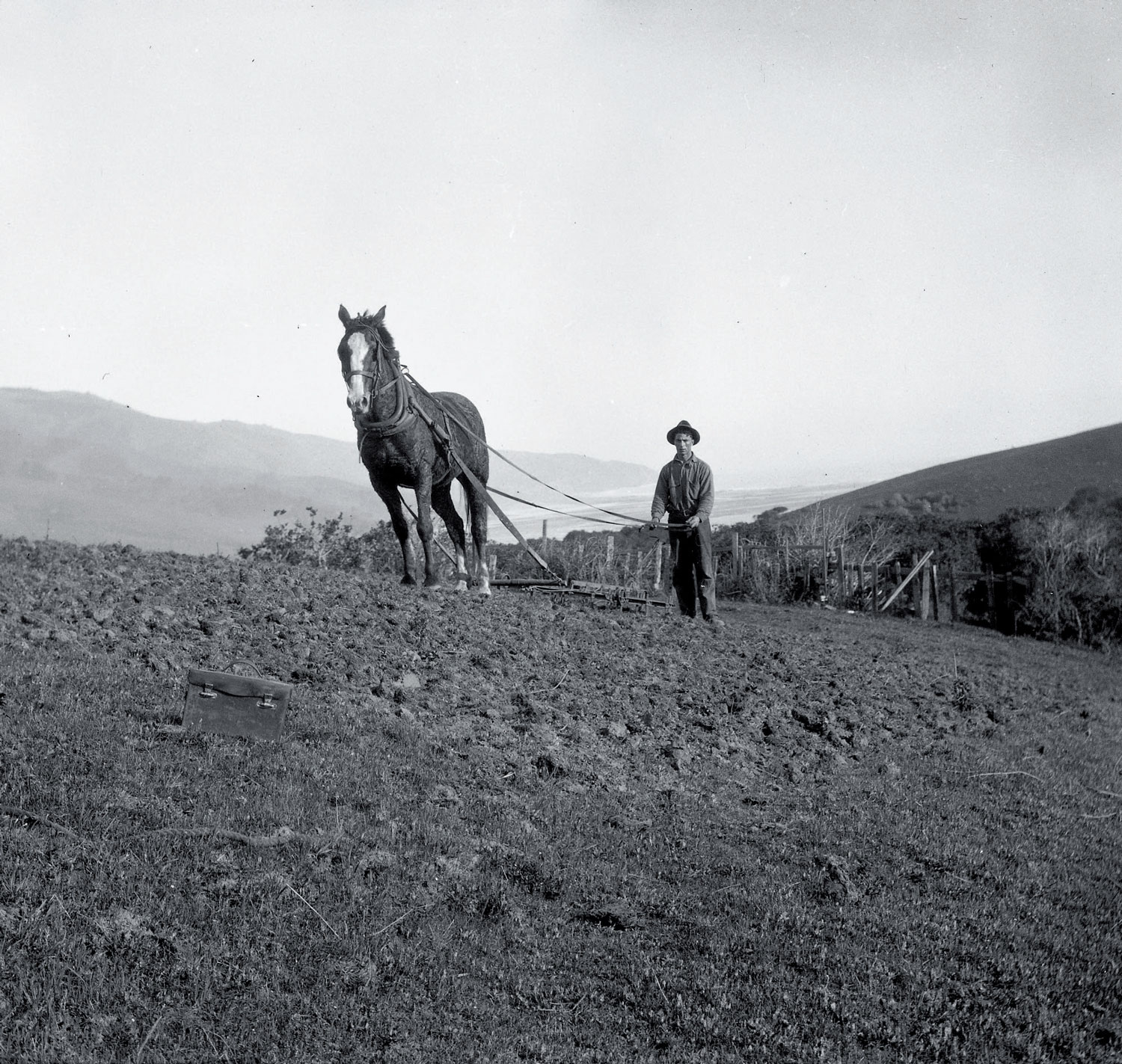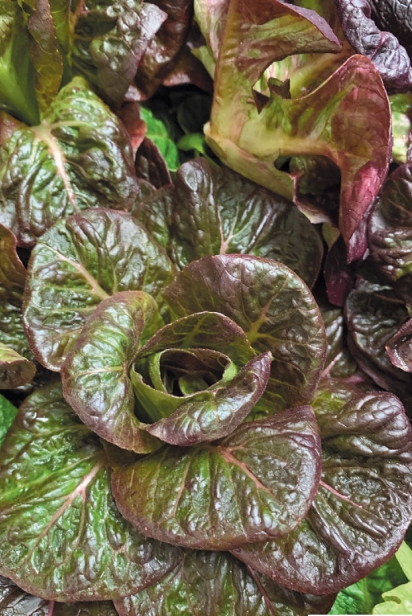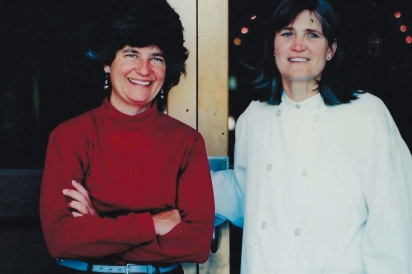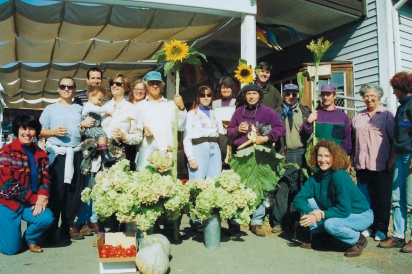Organically Growing Organic
GROWERS IN WESTERN MARIN AND SONOMA COUNTIES HAVE LED THE WAY FOR THE PAST 100 YEARS
From the rich valley of organic row crops cultivated by Zen Buddhist practitioners near Muir Beach, to the wind-battered cattle ranches of the Point Reyes National Seashore, to the silver-green sheep pastures stretching east from Bodega Bay, western Marin and Sonoma counties are an internationally recognized mecca for “alternative agriculture,” drawing everyone from sustainable farming advocate the Prince of Wales to aspiring young farmers looking to become part of a paradigm for the future of food systems.
How, and why, did this come to be?
Over the past 100 years, the region has evolved, making a remarkable transformation from conventional ranching breadbasket to global model for organic agriculture. In my interviews for this article with a handful of the key players in this evolution, I noted an overarching pattern: Each of them gave credit to the others. It was so striking, in fact, that it led me to posit that this ethos of community—the idea that the whole is greater than the individual—was its own “fertilizer” for success.
A HISTORY OF COOPERATION
The word cooperative is built into the title of the University of California Cooperative Extension and, indeed, the mission of the organization that is celebrating its 100th anniversary this year is based on a cooperative model: Researchers and scientists from the University of California work with local farmers and ranchers throughout the state to develop and integrate the most innovative practices for long-term viability.
“It has been a privilege for the UCCE to work with producers who want to try new things, and want to let us research and work with them,” says David Lewis, the current director of the UCCE’s operations in Marin County. “Marin has been and continues to be a leader on that front.”
The statewide UCCE program evolved out of the Land-Grant College Act of 1862, signed by President Abraham Lincoln to reserve 30,000 acres of public land in each state for public universities, and the Grange Movement of the late 1800s, designed to help farmers and ranchers survive natural disasters and economic downturns.
The UCCE appointed its first Farm Advisor to the Marin County region, M.B. (“Boissie”) Boissevain, in 1920. At the time, Marin was known primarily as a “cow haven,” producing milk and butter that was transported by boat from Bolinas or Tomales to consumers throughout the state. The book M.B. Boissevain, Marin’s First Farm Advisor; Historical Photographs of Marin’s Agrarian Roots: 1920–1950 (Regents of the University of California, 2012) features Boissevain’s remarkable black-and-white photos of these early days.
According to Marin historian Dewey Livingston’s introduction to the book, Boissie’s Model T Ford, emblazoned with University of California logo on the side, was a regular sight in the 1920s and ’30s as he drove the dirt roads of the county, traveling between farms to check in on a rotational grazing technique, a new forage crop or an innovative pruning method.
The 1900s not only brought success to the dairy and poultry industries in the North Bay, but also the establishment of robust fruit orchards, as well as artichoke and pea fields. But when the Golden Gate Bridge opened in 1937, more people began to move north, increasing the pressure to turn farmland into suburban housing developments. According to University of California statistics, there were 200 dairy ranches in Marin in 1950. By 1960 that number was down to 150. In 1972 there were fewer than 100.
MARIN AGRICULTURAL LAND TRUST
By the 1970s, North Bay environmentalists began activating to establish zoning laws and preserve open spaces in response to this “urban sprawl,” and ranchers and farmers also began to work, at first individually and then as a united front, to preserve agricultural land.
Bill and Ellen Straus, whose families had fled the Nazis in Germany and Amsterdam, respectively, had purchased a dairy farm in the town of Tomales in 1941. Ellen, whose acknowledged inspiration was Rachel Carson’s Silent Spring, had previously developed a close friendship with wetland biologist Phyllis Faber, and the two found themselves in an unusual position poised to bridge the interests of the environmental and agricultural conservation movements—then, as now, interests often at odds with each other. In 1980, the two women gathered together a group of ranchers and environmentalists and established the Marin Agricultural Land Trust (MALT), with a mission to preserve a great swath of Marin County for agricultural use.
“My mother was a collaborator,” says Albert Straus, founder and CEO of Straus Family Creamery. “She had a way of getting people to come together, to work together, without anyone realizing she was doing it.” Straus reflects on the 1980s and early ’90s as the beginning of an era when local ranchers and farmers shifted to become a more collaborative community, pursuing interaction with each other and with the public.
“We went from an anonymous ‘different’ kind of farming that didn’t have much to sell directly to the public, to becoming small-scale farmers, looking toward the public and the community supporting us,” says Straus. “West Marin was probably one of the first places in the world where we were visible and cohesive enough to make a difference. We began to consider the whole local farming system.”
Also instrumental in the founding of MALT was third-generation dairy farmer Al Poncia, whose son Loren, along with his wife, Lisa, now raise organic grass-fed beef, lamb and pork on the Poncia family land now known as Stemple Creek Ranch. Al Poncia and his wife, Cathie, were some of the earliest conservationists among ranchers in the region, restoring creeks, protecting wildlife habitat and welcoming school students to their land for agricultural and environmental education. The elder Poncia understood that adaptation would sustain the family farm’s existence, and supported Loren who, after graduating from Cal Poly, returned home and moved the family farm toward organic methods in the late 1980s.
Like all significant movements, it is possible with hindsight to look back and recognize the essential players, and the synchronicity of the actions that precipitated change. In the case of the North Bay agricultural community, the groundwork for change was laid by many—Boissevain, Ellen Straus and Al Poncia included—who set the stage for a fairly rapid transformation of the historical farming model.
THE RISE OF ORGANIC PRACTICES
Star Route Farms
Another key player was Warren Weber, a PhD from Berkeley who moved to Bolinas in 1974 to grow organic row crops—by hand— on a property called Star Route Farms. As Weber’s farm began to produce organically grown delights, Alice Waters’ Chez Panisse restaurant in Berkeley was gaining recognition in the local, national and international culinary world. Waters, like other chefs who were members of California’s vanguard farm-to-table food movement, made her name utilizing the uniquely flavorful organic produce from small-scale farmers like Weber. Matches made in agricultural history.
“I was cooking at Chez Panisse and it was at that time that Warren developed organic certification rules—he helped start California Certified Organic Farmers (CCOF), and to write the organic standards that we are still using today,” says Peggy Smith, co-founder with Sue Conley of Marin’s storied Cowgirl Creamery. “He was the kingpin of this whole thing, and he was always very supportive of anyone else who wanted to move into that arena.”
Conley, who had co-founded the popular Bette’s Oceanview Diner on Fourth Street in Berkeley, was drawn to the town of Point Reyes for its increasing energy around organic practices, so much so that she moved to the sleepy town in 1989. “When I moved to West Marin I met a couple of characters who were also interested in highlighting locally grown food,” says Conley. At the time, not many farmers were selling direct to consumers. James Stark and his wife, Penny Livingston, who had started the Permaculture Institute near Bolinas, were two of the important characters Conley met at that time. Conley and James Stark began to germinate the idea that they could deliver organic produce directly to the public.
The West Marin Growers and the Point Reyes Farmers’ Market
“James and I decided we should have a farmers’ market in Point Reyes,” says Conley. “So we went to the Farm Bureau and to MALT but at the time, the response was ‘There are no farmers in Marin, we are all ranchers.’” Evidence that, even in the late 1980s and early ’90s, while small row-crop growers were becoming the stars of the restaurant world, back home they were not yet viewed as a seminal part of the West Marin agricultural landscape.
That was about to change as the group of like-minded producers, including Weber, Conley and Smith, Peter Martinelli of Fresh Run Farm, Janet Brown of Allstar Organics, Peter Worsley of Worsley Farms, Ellen Straus and others gained momentum promoting their shared vision of an organic and sustainable agricultural system for the region’s foodshed.
“We started an organization called West Marin Growers to see if we could find enough people in the community to start a farmers’ market,” recalls Conley. “The restaurateurs said they would be supportive if we only used local growers, so we put an ad in the Pt. Reyes Light, not knowing if there would be enough interest. We were shocked! Thirty people came to our first meeting.”
Chris Giacomini, owner of Toby’s Feed Barn, stepped up and offered to host the market at his barn, and so the iconic Point Reyes Farmers Market was launched. “There were only eight to 10 of us in those first meetings,” recalls Giacomini. “But we could feel that West Marin was becoming an epicenter for organic agriculture.”
Marin Organic
West Marin Growers, at the time completely volunteer run, knew that it needed to find a way to increase its visibility and reach, both within the farming community and through outreach to food service and consumers, according to Conley. Part of that was finding a name that spoke to its reason for being. “So we came up with two words, ‘Marin’ and ‘Organic,’ to describe where and how,” she recalls. “It was a very simple concept.” In 1999, the nonprofit known as Marin Organic was born.
The organization aimed, internally, to identify criteria for sustainable and organic local food production and to work with the Marin County Agricultural Commissioner to establish standards for organic certification. On the consumer-facing side, even though it was still the early days of the world wide web, these organizing farmers used technology to create a website that listed the profiles of all of its member farmers, fostering a sense of personal connection and community with consumers and local restaurants. Marin Organic member farmers also sold their produce at various regional farmers’ markets, furthering their direct connection with customers.
“All of us had our heads down. We weren’t really doing this in an organized way. We were just developing these ideas together,” says Conley. “What happened once Marin Organic was established was organic growth of organic agriculture.” The three pillars of sustainability—economic prosperity, environmental stewardship and social equity—all coalesced in one place and moment.”
“It was a really interesting time, when things were taking off,” says Michael Dimmock, the consultant who helped facilitate the launch of Marin Organic. “It was early to mid-’90s, about the same time that Slow Food was coming to the U.S., and awareness started to develop around local organic food systems.” At the same time, Dimmock adds, industrial food producers were flooding the markets and prices were dropping, so collaboration became about survival—strategizing to find a way to make it as a small farmer. “What happened in West Marin worked because there were a lot of creative people who had a similar value set,” adds Dimmock. “They were environmentally minded, they cared about quality and health, so the only struggles were about how you organize, and where money would come from. They worked through that and it [Marin Organic] became the first organization of its kind that was organically focused.”
Like-Minded Local Government Officials
Four-term Marin County Supervisor Steve Kinsey, along with Stacy Carlsen, who was appointed Marin Agricultural Commissioner in 1995 and remains in the position today, were both essential partners to these West Marin and Sonoma farmers. So was then UCCE Marin County Farm Advisor Ellie Rilla (the fifth after Boissie), who worked closely with Marin Organic, facilitating relationships with local and state agricultural departments, and creating programs for farmers who were interested in moving from conventional to organic agriculture.
“For instance, Ellie Rilla and the UCCE staff organized a program in 1998 at our building in Point Reyes,” says Cowgirl Creamery’s Peggy Smith. “It was for dairies that were having financial problems, [helping them] to create a secondary income through cheesemaking. We didn’t know if anyone would come, but it was full—the Lafranchis [now owners of Nicasio Valley Cheese Company] came, the Giacominis [now owners of Point Reyes Farmstead Cheese Company] ... important dairy families showed up.”
As small farms and producers thrived, forming direct relationships with consumers and food service partners, and Marin Organic, MALT, UCCE and the Marin County Agricultural Commission worked together to fuel this growth, the outside world began to take notice.
In 2005, Prince Charles and Camilla Parker Bowles visited the Bay Area. Their limousine made a beeline to West Marin, the royal couple eager to examine the soil, sample the produce and see for themselves what the buzz was about. In 2007, Saveur, a popular national food magazine, highlighted various members of the small-scale farming community in an article entitled “Farming for the Love of Food,” authored by writer Peggy Knickerbocker.
All the while, top chefs were requesting more Marin- and Sonomagrown organic bounty for their menus.
As consumers and chefs recognized both the superior taste and the environmental significance of fresh, sustainably farmed organic food, the practices and innovation of North Bay producers set the bar.
THE LEGACY AND WORK CONTINUE
“Growers of West Marin and Sonoma County are a tribute to adaptability and creativity,” says Dimmock, currently president of the nonprofit Roots of Change, who has seen a wide swath of agricultural communities in his career as a food system consultant and food policy advisor. “They doubled down on the idea of health and resilience of the agricultural community.” Albert Straus agrees, and also speaks of the ongoing challenge to innovate and strategize in order to make alternative models continue to work.
In 1994, Straus Family Creamery became the first 100% organic certified creamery in the U.S., and today the company supports other local dairies as they work to become organic and sustainable. “In Marin and Sonoma County, 85% of dairies are now certified organic,” says Straus. “We were the first, and now there are 12 organic dairies supplying our creamery, including our own.”
According to Straus, a relationship-based system that collaborates by sharing practices and managing supply has been paramount for success, not only for his business, but for all small-scale dairies in the region. “Twice a month we pay for milk from [other] farms, and we hand-deliver the checks to build our relationships. Four times a year we get all the farmers together to talk about sales, what we’re working on at the farm, we talk about challenges on the farm, such as sustainability. We have a sustainability department to work on practices on the farms,” says Straus. “And, we have an addendum to our contract that sets a volume per farm that is in line with our sales. The price has only gone down 10%, versus our competition which has seen prices drop 20–60% since the all-time price high during five years of drought.”
Of particular importance to Straus are three dairies now run by the younger generation, including two that are multi-generational dairies that have adopted organic practices. “Many of these dairies are fifth-and sixth-generation dairies,” says Sue Conley, who, as an artisan cheesemaker, has had a front row seat to the evolution of local dairies. “These are very good farmers. Without that heritage, we wouldn’t be where we are.”
TODAY’S CHALLENGES AND LOOKING AHEAD
What do these original shepherds of the movement view as the most important challenges faced by the organic local farming community today? Affordable housing for farm laborers is seen as critical to the survival of the region’s sustainable agriculture. Environmental innovations are also seen as key to ongoing success.
UCCE Director Lewis describes the new era of partnerships in agriculture, with a deepening focus on environmental work. “There was a 20- to 30-year window where diversification made sense, and became a mainstay,” says Lewis. “Now, with the maturity of these practices, our approach to environmental stewardship and sustainability is really coming online.”









